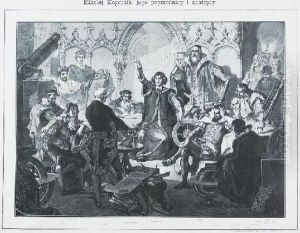Michal Elwiro Andriolli Paintings
Michal Elwiro Andriolli was a Polish illustrator, painter, and architect who is best known for his work as an illustrator of literary classics and his contributions to the art of his time. Born on November 2, 1836, in Vilna, which was then part of the Russian Empire (now Vilnius, Lithuania), Andriolli was part of the Polish-Lithuanian nobility. His artistic talent became evident early on, and he pursued his passion for art throughout his life.
Andriolli studied at the School of Fine Arts in St. Petersburg and later in Paris. His education in the arts was comprehensive, encompassing various disciplines, which allowed him to work in different media and styles. He was significantly influenced by the Romantic movement and its emphasis on emotion, individualism, and the glorification of the past and nature.
Throughout his career, Andriolli was involved in several major projects. He gained widespread recognition for his illustrations for the epic Polish poem 'Pan Tadeusz' by Adam Mickiewicz. His illustrations were notable for their detailed and evocative portrayal of 19th-century Polish nobility and rural life. Andriolli's work was instrumental in visualizing Polish literary culture and history, especially at a time when Poland was partitioned between Russia, Prussia, and Austria and struggling to maintain its cultural identity.
In addition to his work as an illustrator, Andriolli was also an accomplished architect. He designed several buildings, including churches and residential buildings, contributing to the architectural landscape in Poland.
Michal Elwiro Andriolli's contributions extended beyond the realm of fine arts. He was an active participant in the January Uprising of 1863, a Polish insurrection against Russian rule. He was later exiled to Siberia for his involvement in the uprising, an experience that deeply affected him and influenced his subsequent work.
Andriolli's legacy is preserved through his prolific body of work, which includes not only illustrations and architectural designs but also paintings and sketches that reflect the cultural and historical context of his time. He died on August 23, 1893, in Nałęczów, Poland. His work continues to be celebrated in Poland and beyond, and he remains an important figure in the history of Polish art.








